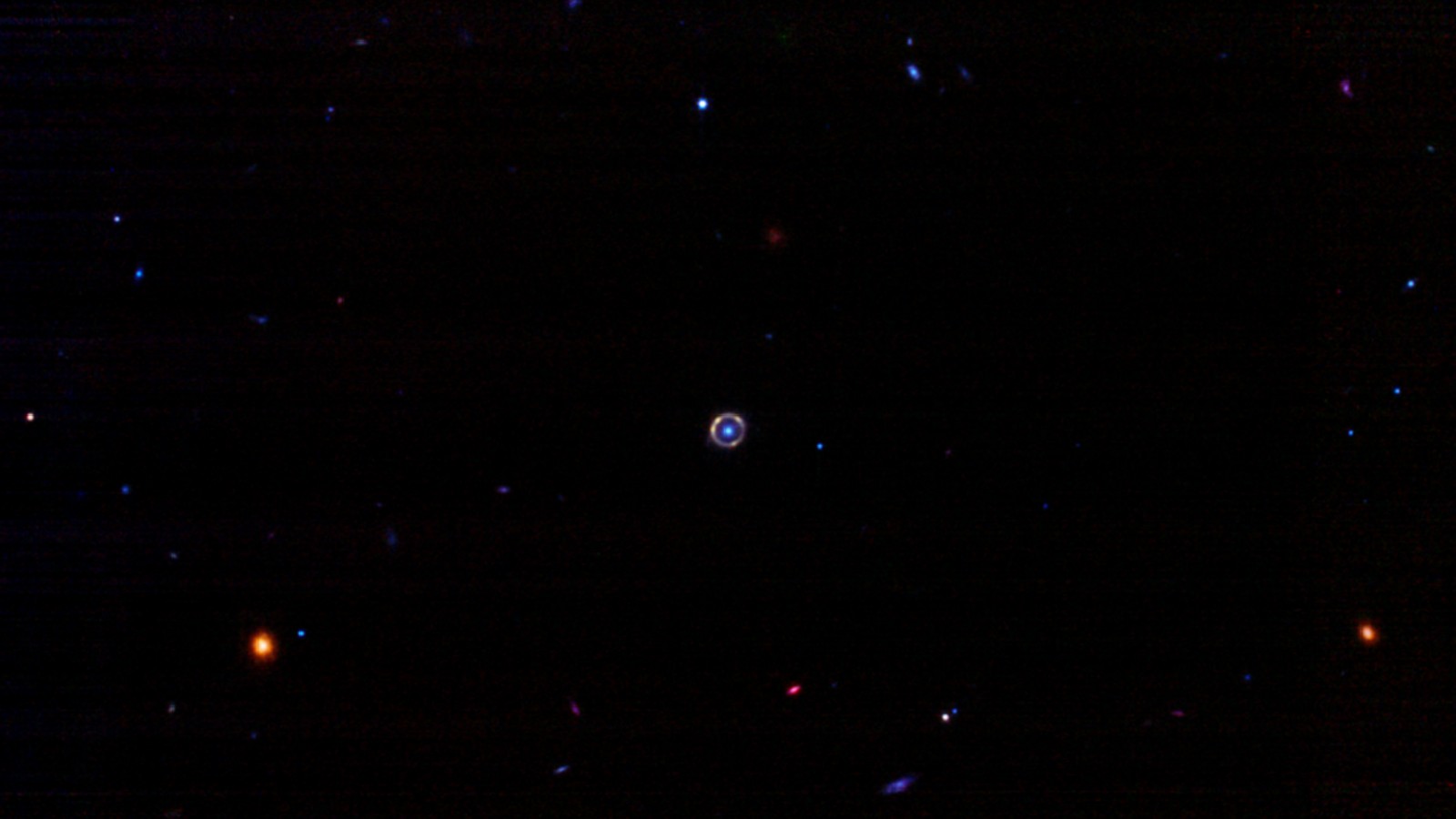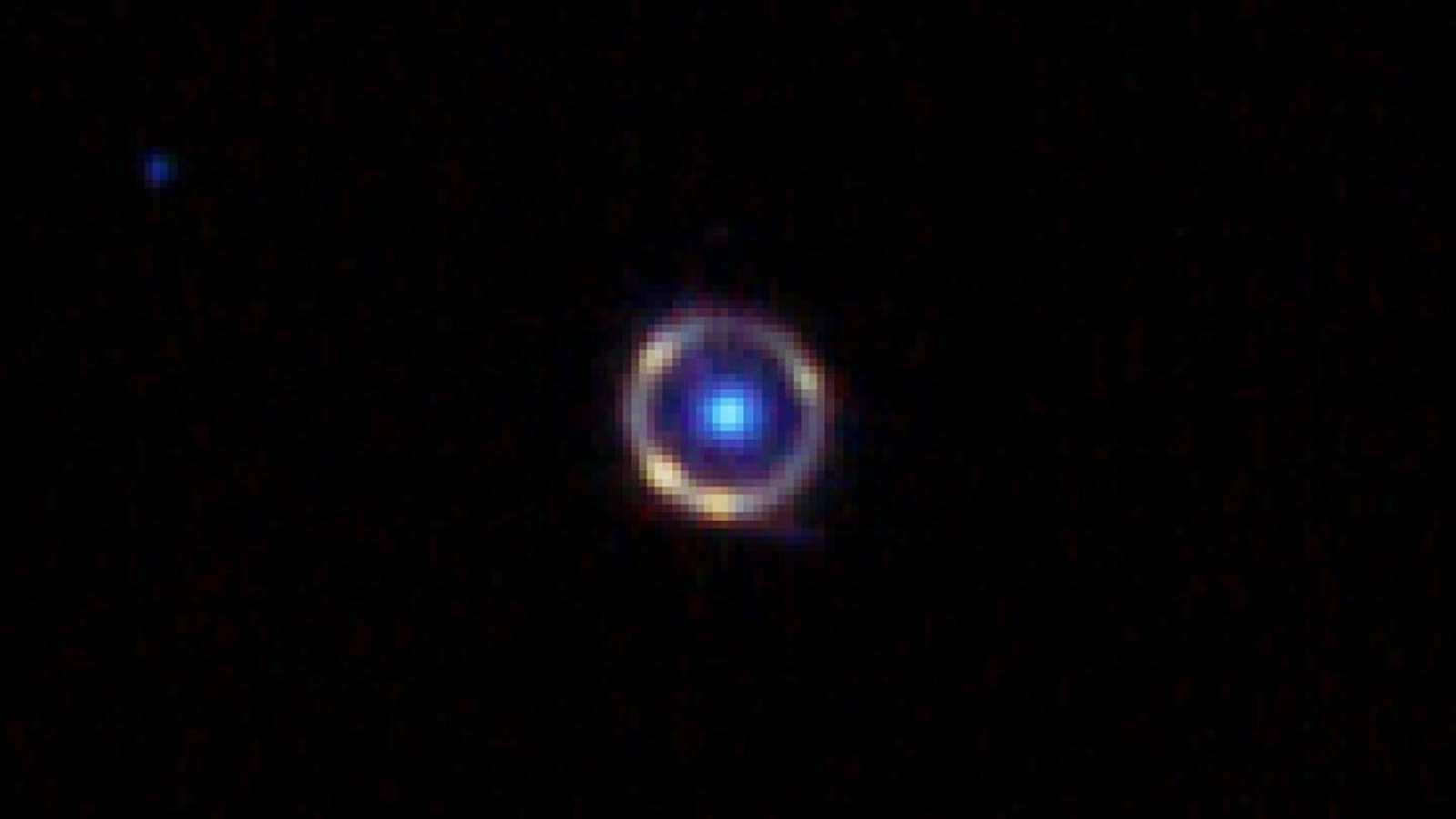Stunningly perfect 'Einstein ring' captured by James Webb Space Telescope
It is our best look yet at these weird gravitationally-warped halos of light.

NASA's James Webb Space Telescope has snapped a perfect shot of an "Einstein ring." The stunning halo is the result of light from a distant galaxy passing through warped space-time surrounding another galaxy aligned between the distant light source and Earth. The new image, which was created by a Reddit-based astronomy enthusiast, is one of the best examples of the trippy astronomical phenomenon ever captured.
The ring of light in the new image comes from the distant galaxy SPT-S J041839-4751.8 (or JO418 for short), which is around 12 billion light-years from Earth, making it one of the oldest galaxies in the universe. JO418 is orientated directly behind another galaxy — the bright blue light at the center of the ring — which is so massive that its gravitational pull warps the space-time around it. As light from JO418 reaches the foreground galaxy it travels through this warped space-time. From Earth, it looks as though the light has curved around the galaxy, but the electromagnetic waves we see have actually been traveling in a straight line the entire time.
This weird effect is similar to how glass lenses redirect light. Like magnifying glasses, this phenomenon also makes the light from distant galaxies appear much closer than they actually are. The only difference is that the lens is made from gravity-mangled space-time instead of glass. As a result, researchers have dubbed this trippy effect, gravitational lensing. Albert Einstein first predicted gravitational lensing in 1912, when he devised his theory of relativity.
Related: 8 ways you can see Einstein's theory of relativity in real life
Reddit user and astronomy grad student "Spaceguy44" posted the image of the JOS18 Einstein ring Aug. 23 in the subreddit r/Astronomy. The anonymous astronomer created the shot using publicly available data collected by the Mid-Infrared Instrument (MIRI) on the James Webb Space Telescope.
"We wouldn't be able to see J0418 if it weren't for the light-bending properties of gravity," Spaceguy44 wrote on Reddit. "Without the lensing effect, the galaxy would probably look like most distant galaxies: a small blob of light."

The new image is not the first glimpse of JO418, but it is by far the most detailed yet.
Get the world’s most fascinating discoveries delivered straight to your inbox.
In 2020, researchers discovered the distant galaxy after spotting partial gravitational lensing with the Atacama Large Millimeter/submillimeter Array (ALMA) in Chile; they reported the finding in a paper published that year in the journal Nature.
On Aug. 13, Spaceguy44 released an image of JO418 using data collected by Webb's NIRCam instrument, but the initial shot had a much lower resolution and the ring of light was less visible, according to ScienceAlert.
NASA's Hubble Space Telescope has captured images of several other Einstein rings, including one formed from warped quasar light. However, none of these Einstein rings was as complete or as clearly visible as the one in the new image.
Perfectly-circular Einstein rings are extremely rare because they require both the distant and foreground galaxies to be perfectly aligned with the observer. However, the more advanced sensors on Webb should make it easier to spot them in the future.
The recently released photo is just the latest example of the high-definition view of the cosmos that Webb will provide to both researchers and the general public. The space telescope, which released its first pictures in July, has already snapped a stunning infrared image of Jupiter, a mesmerizing view of the Cartwheel Galaxy, the deepest image of the universe ever taken and other jaw-dropping photos.
Originally published on Live Science.

Harry is a U.K.-based senior staff writer at Live Science. He studied marine biology at the University of Exeter before training to become a journalist. He covers a wide range of topics including space exploration, planetary science, space weather, climate change, animal behavior and paleontology. His recent work on the solar maximum won "best space submission" at the 2024 Aerospace Media Awards and was shortlisted in the "top scoop" category at the NCTJ Awards for Excellence in 2023. He also writes Live Science's weekly Earth from space series.
